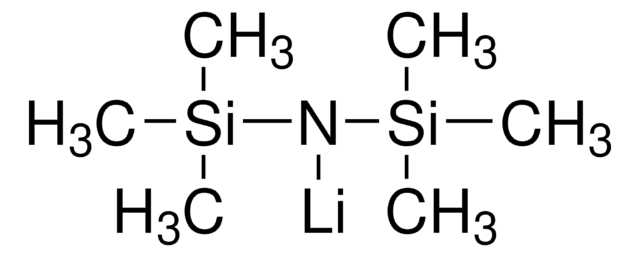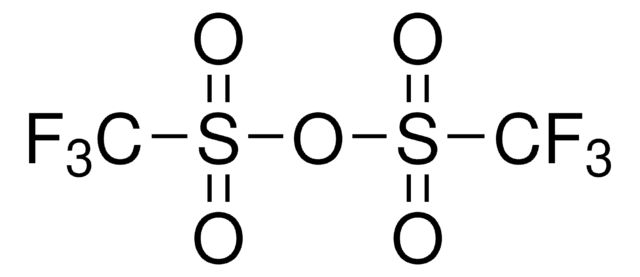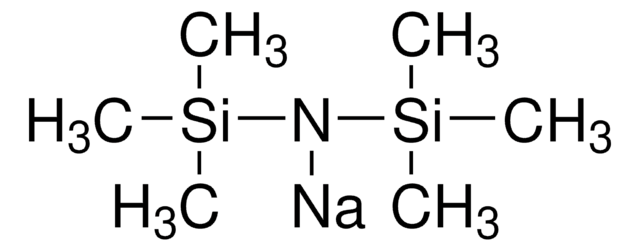추천 제품
일반 설명
Lithium bis(trimethylsilyl)amide (LHMDS) is a non-nucleophilic strong base widely used in organic synthesis for deprotonation reactions and base-catalyzed reactions. It is generally soluble in most nonpolar organic solvents.
애플리케이션
Lithium bis(trimethylsilyl)amide solution (1.0 M in THF) can be used as a base:
- To catalyze polymerization reaction in the synthesis of poly(p-benzamide)s.
- In the synthesis of cyclic poly(α-peptoid)s and α-(difluoromethyl)styrene.
- In directed aldol condensations and Darzens condensation reactions; α-arylation of aryl ester derivatives and allylic amination reaction.
- For the generation of kinetic enolates than sodium hexamethyldisilazide (NaHMDS) because the enolates produced are more regiostable than those produced with NaHMDS.
포장
The 25 mL Sure/Seal™ bottle is recommended as a single-use bottle. Repeated punctures will likely result in decreased performance of product.
법적 정보
Sure/Seal is a trademark of Sigma-Aldrich Co. LLC
신호어
Danger
유해 및 위험 성명서
Hazard Classifications
Carc. 2 - Eye Dam. 1 - Flam. Liq. 2 - Skin Corr. 1B - STOT SE 3
표적 기관
Central nervous system, Respiratory system
보충제 위험성
Storage Class Code
3 - Flammable liquids
WGK
WGK 2
Flash Point (°F)
1.4 °F - closed cup
Flash Point (°C)
-17 °C - closed cup
이미 열람한 고객
Macromolecules, 39, 5347-5347 (2006)
Nan Li et al.
Lab on a chip, 8(12), 2105-2112 (2008-11-22)
High-density live cell array serves as a valuable tool for the development of high-throughput immunophenotyping systems and cell-based biosensors. In this paper, we have, for the first time, demonstrated a simple fabrication process to form the hexamethyldisilazane (HMDS) and poly(ethylene
Tatsuya Nitabaru et al.
Journal of the American Chemical Society, 131(38), 13860-13869 (2009-09-10)
Full details of an anti-selective catalytic asymmetric nitroaldol reaction promoted by a heterobimetallic catalyst comprised of Nd(5)O(O(i)Pr)(13), an amide-based ligand, and NaHMDS (sodium hexamethyldisilazide) are described. A systematic synthesis and evaluation of amide-based ligands led to the identification of optimum
Juliana Tsz Yan Lee et al.
Scanning, 34(1), 12-25 (2012-04-26)
Common dehydration methods of cells on biomaterials for scanning electron microscopy (SEM) include air drying, hexamethyldisilazane (HMDS) or tetramethysilane (TMS) treatment and critical point drying (CPD). On the other side, freeze-drying has been widely employed in dehydrating biological samples and
Xiaoguang Li et al.
Chemical communications (Cambridge, England), 47(38), 10761-10763 (2011-08-30)
A silica microsphere suspension and a silica sol are employed in a two-step dipping process for the preparation of a superhydrophobic surface. It's not only a facile way to achieve the lotus effect, but can also create a multi-functional surface
자사의 과학자팀은 생명 과학, 재료 과학, 화학 합성, 크로마토그래피, 분석 및 기타 많은 영역을 포함한 모든 과학 분야에 경험이 있습니다..
고객지원팀으로 연락바랍니다.











